Date Posted: September 20, 2011
Print Edition: September 14, 2011
 Gender inequality became a surprise controversy during a panel discussion in mid-August at the Melbourne Freeplay games festival. The panel discussion included, most notably, Zero Punctuation’s Ben “Yahtzee” Crosshaw, as well as literary and theatre critic Alison Croggon and the owner of JumpButton game magazine, Drew Taylor. When the panel was asked to answer the question “Where are all the female game critics?” the waves were felt throughout the game industry.
Gender inequality became a surprise controversy during a panel discussion in mid-August at the Melbourne Freeplay games festival. The panel discussion included, most notably, Zero Punctuation’s Ben “Yahtzee” Crosshaw, as well as literary and theatre critic Alison Croggon and the owner of JumpButton game magazine, Drew Taylor. When the panel was asked to answer the question “Where are all the female game critics?” the waves were felt throughout the game industry.
Part of the issue is that there are, in fact, quite a number of female game critics, but even though some are winning awards for their work, they continue to struggle to gain mainstream visibility. Critical Distance senior editor Ben Abraham spoke about this on his blog, upset that even within the panel, a certain apathy was shown to the fact that though there are female game critics, they were made invisible despite the panel discussing their struggle for visibility. To her credit, Croggon spoke of the built-in sexism that virtually every industry faces in our culture, even within her field of literary criticism. “…It’s absolutely true that women face structured difficulties that men don’t face. It’s just a fact…you can just take it as read that if there’s a woman’s name attached to something it will attract less notice,” she said. “It doesn’t matter about the content at all. And if you want to achieve any kind of prominence, and it’s still the case, you have to be three times as good as any man.”
During the discussion there were also noteworthy tweets by players and game designers. To help make his final point, Abraham quoted a tweet by designer Ben Britten, who said: “Gender disparity is a society wide problem, it would be great if the game community could be at the forefront of the change.” Rob Reid tweeted a similar message from the conference: “Gamers are problem solvers. Surely if there’s a community that can figure out how to recognize the women amongst them it’s us.” I have to agree with Abraham that these are great thoughts, and it would be so inspiring to see the medium of video games used to tackle some of these issues. After all, one of the strengths of a quality video game is its ability to put you in the shoes of someone else.
However, game producer and designer Asa Roos just wrote a column last week that appeared on video game website Gamesutra in which she critiques Abraham’s conclusion. Abraham claims that gamers and developers are “some of the best and brightest people on the planet” and that “if anyone can address this and other problems like it, we can.” Roos challenged the notion, wondering why, if that were the case, games, in fact, had more than their share of sexism, racism and other stereotypes. She pointed to Lara Croft, the female lead character of Tomb Raider, often touted as an example of a strong female lead, but better known for her large breasts. Sure, there are an increasing number of games that feature female characters with their own values, journeys and character development. However, we are a long way away from being at the forefront of change, especially considering the financial risk of investing in a game that might not find an audience – gamers have to be willing to pay for it, after all.
The good news is that as casual gaming grows, so too does the female audience. With the additional benefit of digital distribution and bite-sized gaming, the ability to make smaller games at lower costs increases the ability of interested developers to pursue games that challenge cultural norms and stereotypes and tell the stories of the oppressed. A good game is a good game, and if done well, stories like that could make all the difference.


